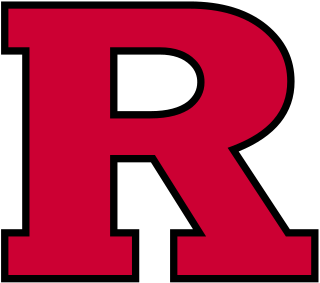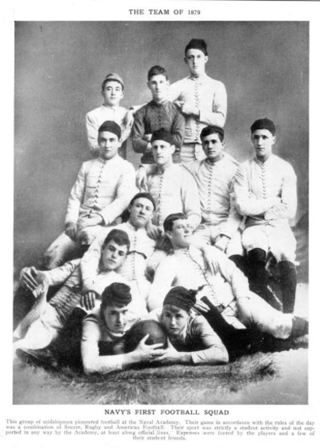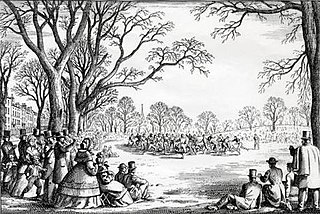
College football refers to gridiron football that is played by teams of amateur student-athletes at universities and colleges. It was through collegiate competition that gridiron football first gained popularity in the United States.

Gridiron football, also known as North American football, or in North America as simply football, is a family of football team sports primarily played in the United States and Canada. American football, which uses 11 players, is the form played in the United States and the best known form of gridiron football worldwide, while Canadian football, which uses 12 players, predominates in Canada. Other derivative varieties include arena football, flag football and amateur games such as touch and street football. Football is played at professional, collegiate, high school, semi-professional, and amateur levels.

The Rutgers Scarlet Knights football team represents Rutgers University in the Football Bowl Subdivision (FBS) of the National Collegiate Athletics Association (NCAA). Rutgers competes as a member of the Big Ten Conference. Prior to joining the Big Ten, the Scarlet Knights were a member of the American Athletic Conference from 1991 to 2013. Rutgers plays its home games at SHI Stadium, in Piscataway, New Jersey. The team is currently led by head coach Greg Schiano. The Scarlet Knights football team is notable for playing in the first ever collegiate football game in 1869, in which the Scarlet Knights won 6–4.

The Rutgers Scarlet Knights are the athletic teams that represent Rutgers University's New Brunswick campus. In sports, Rutgers is famously known for being the "Birthplace of College Football", hosting the first ever intercollegiate football game on November 6, 1869, in which Rutgers defeated a team from the College of New Jersey with a score of 6 runs to 4.

American football, also known as gridiron football, is a team sport played by two teams of eleven players on a rectangular field with goalposts at each end. The offense, the team with possession of the oval-shaped football, attempts to advance down the field by running with the ball or throwing it, while the defense, the team without possession of the ball, aims to stop the offense's advance and to take control of the ball for themselves. The offense must advance at least ten yards in four downs or plays; if they fail, they turn over the football to the defense, but if they succeed, they are given a new set of four downs to continue the drive. A game is won by the team with the higher number of points, which are scored primarily by advancing the ball into the opposing team's end zone for a touchdown or kicking the ball through the opponent's goalposts for a field goal.

The Princeton Tigers football program represents Princeton University and competes at the National Collegiate Athletic Association (NCAA) Division I Football Championship Subdivision (FCS) level as a member of the Ivy League. Princeton's football program—along with the football program at nearby Rutgers University—began in 1869 with a contest that is often regarded as the beginnings of American football.
The 1869 college football season was the first season of intercollegiate football in the United States. While played using improvised rules more closely resembling soccer and rugby than modern gridiron football, it is traditionally considered the inaugural college football season. The 1869 season consisted of only two games, both between Rutgers and Princeton. The first game was played on November 6 at Rutgers' campus, and the second was played on November 13 at Princeton's campus. Both games were won by the home team.
The 1870 college football season is regarded as the second United States intercollegiate football season. The season involved only three teams and two known games which took place in November 1870. As in 1869, the season's two games occurred about fifteen miles apart in New Brunswick and in Princeton, New Jersey.

Football is a family of team sports that involve, to varying degrees, kicking a ball to score a goal. Unqualified, the word football normally means the form of football that is the most popular where the word is used. Sports commonly called football include association football ; Australian rules football; Gaelic football; gridiron football ; International rules football; rugby league football; and rugby union football. These various forms of football share, to varying degrees, common origins and are known as "football codes".
The Rutgers Scarlet Knights men's soccer team is a varsity intercollegiate athletic team of Rutgers University–New Brunswick in New Brunswick, New Jersey, United States. The team is a member of the Big Ten Conference, which is part of the National Collegiate Athletic Association's Division I. Rutgers's first varsity's men's soccer team was fielded in 1938, although organized soccer has been played at the university since at least 1869. The team plays its home games at Yurcak Field in New Brunswick. The Knights are coached by Jim McElderry.

The 1879 Navy Midshipmen football team represented the United States Naval Academy in the 1879 college football season. The team was the 1st season intercollegiate football squad to represent the United States Naval Academy. The team had no coach, as it was entirely student-operated; however, it was captained by squad member Bill Maxwell. The team played just a single game, which was a scoreless tie with the Baltimore Athletic Club. The team was entirely student operated, and was not supported by the Naval Academy's faculty. The school would not have another football squad until 1882.

The 1882 Navy Midshipmen football team represented the United States Naval Academy in the 1882 college football season. The team was the second intercollegiate football squad to represent the United States Naval Academy, and the first since 1879. The team was coached by player-coach Vaulx Carter, and was entirely student-operated. It was captained by squad member Alex Jackson. The team played just a single game, an 8 to 0 (8–0) shutout of Johns Hopkins, which was the school's first ever win. The squad was entirely student operated, and was not supported by the Naval Academy's faculty. The season would mark the beginning of eight season rivalry between the Midshipmen and Johns Hopkins.
The 1869 Rutgers Queensmen football team represented Rutgers University in the 1869 college football season. The team finished with a 1–1 record and was retroactively named the co-national champion by Parke H. Davis. They played Princeton two times, splitting the series one game each. The team had no coach, and was captained by William Leggett.
The 1881 Princeton Tigers football team represented the College of New Jersey, then more commonly known as Princeton College, in the 1881 college football season. The team finished with a 7–0–2 record and was retroactively named national champion by the Billingsley Report and as co-national champion by Parke H. Davis. This season marked Princeton's 11th national championship in a 13-year period between 1869 and 1881. P. T. Bryan was the captain of the team.

The Johns Hopkins–Navy football rivalry was an American intercollegiate football rivalry between the Johns Hopkins Blue Jays football team of Johns Hopkins University and the Navy Midshipmen football team of the United States Naval Academy. The two institutions, located within the span of a few miles in the state of Maryland, first met for a football game in 1882. Following the initial contest, both teams played each other annually for eight years, before it was called off for unknown reasons. The teams competed again in 1911 and 1912, again disbanding the contest until a final match took place in 1919.
The 1884 Navy Midshipmen football team represented the United States Naval Academy in the 1884 college football season. The team was the fourth intercollegiate football squad to represent the United States Naval Academy, and was the final time the school played a single-game season. The squad was captained by rusher Jim Kittrell. The team's single game was a 9 to 6 (9–6) defeat of rival-school Johns Hopkins. The season continued a seven-season, eight game rivalry between the Naval Academy and Johns Hopkins. It was the final season that a Naval Academy team would go unbeaten and untied.

The early history of American football can be traced to early versions of rugby football and association football. Both games have their origin in varieties of football played in Britain in the mid–19th century, in which a football is kicked at a goal or run over a line, which in turn were based on the varieties of English public school football games.
The Intercollegiate Football Association (IFA), also known as the American Intercollegiate Football Association, was one of the earliest college football rules-making and scheduling organizations in existence; it was active from the 1873 to 1893 seasons. The IFA teams, Columbia, Harvard, Princeton, and Yale, are now members of the Ivy League.

The Princeton–Rutgers rivalry is a college rivalry in athletics between the Tigers of Princeton University and Scarlet Knights of Rutgers University – New Brunswick, both of which are located in New Jersey. The rivalry dates back to the first college football game in history in 1869. Although the football series ended in 1980 due to the two schools going in different directions with their football programs, the rivalry has continued in other sports, primarily in men's basketball.

The Boston game, also known as the Boston rules, was an early code of football developed by the Oneida Football Club, formed in 1862 and considered by some historians as the first formal "football" club in the United States. Rules allowed carrying and kicking and is considered the first step to the codification of rules for association football, rugby football, or American football. After Oneida disbanded, former members established the Harvard University Football Club, which continued to play football under those rules.















